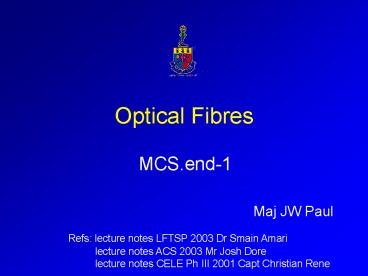Optical Fibres - PowerPoint PPT Presentation
1 / 27
Title:
Optical Fibres
Description:
... Fibres. Maj JW Paul. Refs: lecture notes LFTSP 2003 Dr Smain Amari. lecture notes ACS 2003 Mr Josh Dore. lecture notes CELE Ph III 2001 Capt Christian Rene ... – PowerPoint PPT presentation
Number of Views:80
Avg rating:3.0/5.0
Title: Optical Fibres
1
Optical Fibres
MCS.end-1
Maj JW Paul
Refs lecture notes LFTSP 2003 Dr Smain Amari
lecture notes ACS 2003 Mr Josh Dore
lecture notes CELE Ph III 2001 Capt Christian Rene
2
Education teaches you what is possibleExperience
teaches you what is not...
3
Review
- What are the sources of loss in metallic cable?
4
The Electromagnetic Spectrum
5
Outline
- Fiber vs. Metallic Cables
- Light Propagation in Fiber
- Types
- Acceptance Cone
- Losses
- Sources and Detectors
6
Introduction
- 1960 Laser invented
- 1966 Concept of transmission in
an optical fiber first proposed - 1970 First low-loss (20 dB/km)
optical fiber ( coaxial cables) - Today Attenuations around 0.15 dB/km are
achievable (theory 0.13) - Plastics and silica are common materials
7
Some properties of light...
- light travels more slowly in an optically dense
medium than it does in a less dense medium - A measure of this effect is the refractive index
(index of refraction) - Gives us refraction and reflection
in vacuum
light
of
Speed
h gt 1
h
material
in
light
of
Speed
8
Reflected Rays
Exit Ray
h2
h1
? a
Partial Reflection
? c
Incident Ray
Reflected Ray
? a acceptance angle
? c critical angle
9
Fiber Cables Design
- Note glass-air interface would provide
sufficient change in h - Cladding protects glass from
- surface scratches,
- surface contaminants..
- Which would let light escape
Typical ? 860 nm 1300 nm 1550 nm
10
Fiber Types
- Plastic core and cladding
- Glass core with plastic cladding
- Also called PCS fiber (plastic-clad silica)
- Glass core and glass cladding
- Also called SCS fiber (silica-clad silica)
- Under development
- Non-silicate (Zinc chloride) which could be 1000
times as efficient as glass
11
Fiber vs. Metallic Cables
- Advantages
- Larger bandwidth
- Immune to cross-talk
- Immune to static interference
- Do not radiate RF
- spark free
- No corrosion, more environment resistive
- Disadvantages
- Initial cost of installation high
- Brittle
- Maintenance and repair more difficult and more
expensive
12
BW comparisons
1 THz (TeraHerz) 1012 Hz 109 Mhz
13
How to change h
step index
gradient index
14
Modes
55km range
single mode
cladding
10?
core
20km range
50?
multi mode - step index
125?
multi mode - gradient index
note high and low order modes
15
Single-Mode Step Index
- Advantages
- Minimum dispersion (one path only)
- Larger bandwidth
- Disadvantages
- Difficult to couple light (small core)
- Small source needed
- Expensive and difficult to manufacture
16
Multi-Mode Step Index
- ADV
- Inexpensive to manufacture, and simple
- Easy to couple light into
- DIS
- Different paths, more dispersion
- Info rate and BW is less
17
Losses in Fibers
18
Attenuation
- Absorption
- interaction of light with electrons molecule
vibration - Rayleigh Scattering
- caused by compositional fluctuations in glass
material. Energy escapes not converted - Material Fabrication
- caused impurities (transition metal ions)
- Fiber Fabrication
- caused by fiber imperfections (defects/stresses)
Leads to Mie scattering which is ?
independent - Deployment/Environmental
- caused by bends and microbends
Leads to mode conversions
19
Splicing Loss
Coupling Surface
Separation Distance
Alignment Angle
Surface Roughness
20
Splicing Methods
- Fusion cut, polish, align and fuse together
by passing current (0.1 dB loss) - Mechanical cut, polish, align then place
mechanical (glued) support sheath around
junction (0.2 dB loss)
21
Modal Dispersion
- Different paths take different times to propagate
- Cause by light beam width not tightly focused
(LED vs Laser beam) - Can occur only in multi-mode fibers
22
Chromatic Dispersion
- Pulse spreading due to the fact that different
wavelengths travel at different speeds in the
fiber. - Major limiting factor in single-mode fibres.
- Not as significant as modal dispersion in
multi-mode fibers.
Lowest for 1300 nm region
23
Pulse-Width Dispersion
- Pulse stretching may cause ISI in digital
transmission - Also caused in multi-mode fibers because of
different paths taken by the rays of light
24
Sources
- LED (light emitting diodes)
- ILD (injection laser diodes
- Pros of ILD
- Easier to couple (more directive beam)
- Output power greater
- Higher bit rate
- Monochromatic (less chromatic dispersion)
- Cons of ILD
- 10 x more expensive
- Shorter lifetime due to high power
- More temperature dependant (performance varies)
25
Detectors
- PIN Diode (most common, a.k.a. Photodiode)
- Avalanche photodiode (different junction than
PIN) - more sensitive than PIN but longer transit time
- Characteristics of Detectors
- Responsivity (measure of conversion efficiency)
- Dark current (leakage current, when no light
present) - Transit time (time to travel across junction,
affects bps) - Spectral response (range of detectable wavelength)
26
Review
- Name the 3 types of fibre cables
- What are the differences between step-index and
graded-index fibers? - Name and describe the main impairments to optical
cables
27
Review
- What are the sources of loss in metallic cable?
- Resisitance
- Inductance
- Capacitance
- Impedence
- Attenuation Distortion
- Delay Distortion
- Crosstalk noise

